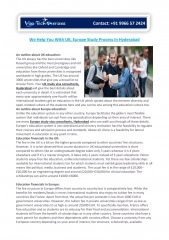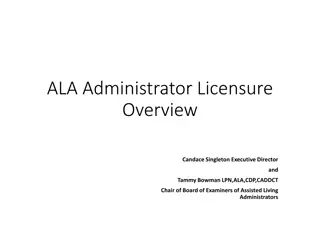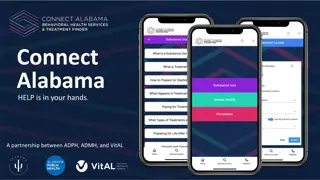Career Choices of Education Majors from Alabama Universities
Explore the career choices of education majors from Alabama universities, highlighting the teacher shortage and decline in education bachelor's degree graduates. Learn about the impact on different education majors and the employment outcomes for graduates in Alabama.
Download Presentation

Please find below an Image/Link to download the presentation.
The content on the website is provided AS IS for your information and personal use only. It may not be sold, licensed, or shared on other websites without obtaining consent from the author.If you encounter any issues during the download, it is possible that the publisher has removed the file from their server.
You are allowed to download the files provided on this website for personal or commercial use, subject to the condition that they are used lawfully. All files are the property of their respective owners.
The content on the website is provided AS IS for your information and personal use only. It may not be sold, licensed, or shared on other websites without obtaining consent from the author.
E N D
Presentation Transcript
Career Choices of Education Majors from Alabama Universities June 3, 2021 1
Alabama Education Bachelors Degree Graduates: 2003 to 2018 2500 2458 15% decline from 2003 to 2018 2400 2300 2200 2089 2100 2000 1900 2003 2004 2005 2006 2007 2008 2009 2010 2011 2012 2013 2014 2015 2016 2017 2018 3
Alabama Bachelors Degrees by Education Major 1400 1151 1200 Elementary Education -27% 1000 838 800 600 498 Physical Education/Coaching +96% 430 400 Secondary Education -58% 254 179 200 0 2003 2004 2005 2006 2007 2008 2009 2010 2011 2012 2013 2014 2015 2016 2017 2018 Math, Science, Language, etc 4
Overview of Alabamas Teacher Shortage In Alabama, 30% of all classrooms are being taught by teachers teaching out of field, having neither a major nor a minor in the field. Only 523 secondary first-time teaching certificates were issued in Alabama in the 2017-18 school year. Alabama has more than 1,700 secondary teachers with emergency certificates or teaching out of field. Since 2010, there has been a 40% decrease in students entering teacher education programs. Each year 8% of teachers leave the profession. Source: Report to Alabama Board of Education, August 2019. 5
Employment Outcomes Report Partnership between Alabama Commission on Higher Education (ACHE) and Alabama Department of Labor (DOL) o ACHE: student major (CIP code), degree, year of graduation, demographics o DOL: employer type (NAICS code), employer location, wage 7
Employment Outcomes Report Report addresses the following questions: o What percentage of Alabama residents and non-Alabama residents who graduate from public two-year and four-year institutions remain in Alabama? o How does level of education impact salary? o What is the average salary by field of study and level of degree of Alabama graduates? https://ache.edu/ACHE_Reports/Reports/Acc ountability/EmploymentOutcomesReport.pdf 8
Workforce Caveats o Alabama DOL workforce data includes employees reported for unemployment insurance. o Does not include individuals who are self-employed, federally employed, enlisted in the military, employed out-of-state, or working without unemployment insurance o Also excludes occasional workers who earn less than $5,000/year 9
Career Choices of Education Majors: Research Questions 10
Are education majors from the 14 public universities: 1. More likely to be found working in the Alabama workforce? Differences by gender, ethnicity, or undergraduate major? 2. For those found in the Alabama workforce, are there Employer type differences by undergraduate major? Wages differences by undergraduate major and employer type? Two subsets 1 year and 5 years after earning degree 11
Education Graduates Research Population 1-year subset # bachelor graduates 0 0 0 1989 2187 1980 6156 5-year subset # bachelor graduates 2346 2331 2415 0 0 0 7092 Graduation Year 2011 2012 2013 2015 2016 2017 Total Subset Sizes 12
Research Population Demographics 1-year subset # bachelor graduates 4757 5-year subset # bachelor graduates 5455 Females Males 1397 1636 1-year subset # bachelor graduates 4692 5-year subset # bachelor graduates 5465 White African American 1066 1308 Other Minority 298 246 13
Research Population Majors # bachelor graduates (both subsets) 1,022 Major Category Early Childhood Ed Elementary Ed 5,376 Secondary Ed 1,385 Subject Specialists 672 Teacher Ed 332 Special Ed 1,031 Physical/Health Ed 3,430 14
Education Graduates Working in Alabama 15
Working in Alabama Complete Education Graduates Population 1 Year After Graduation 5 Years After Graduation 6,156 graduates 7,092 graduates (2015, 2016, 2017) (2011, 2012, 2013) 72% 66% High likelihood Education Graduates will work in Alabama. 16
Working in Alabama by Gender* 1 Year = 72% 5 Years = 66% Females more likely to be found working in Alabama. 73% 69% 67% 64% Female Male * Differences are statistically significant 17
Working in Alabama by Race/Ethnicity* Drop from year 1 to 5 similar for white and AA graduates. Difference is stat. sig. for other minorities, but total number graduates is low. 1 Year = 72% 5 Years = 66% 72% 74% 67% 65% 59% 53% *Differences stat. sig. when include Other. NOT stat. sig. with only white & AA students. White African American Other Minority 18
Working in Alabama by Education Major* Decrease between year one and five is significant issue in assuring we have enough teachers in the right teacher specialties 8-10% decrease 1 Year = 72% 5 Years = 66% 80% 80% 79% 72% 72% 72% 72% 69% 68% 66% 63% 62% 57% 56% Early Elementary Secondary Subject Spec Teacher Ed Special Ed Physical/ Health Childhood * Differences are statistically significant 19
Employer Types for Education Majors Education Majors in Alabama work for these four Employer Types: 1. K-12 Education public & private 2. Education Other child care centers, higher education, non-profits, government, etc. 3. Health Related public & private related to health care 4. Other Sectors service industry, clerical, and temporary employment 21
Employer Types for Education Graduates in Alabama 1 Year After Graduation K-12 Education Education Other Health Related Other Sectors 6% 10% 10% 10% 10% 16% 7% 20% 19% 9% 43% 23% 90% 88% 80% 75% 70% 70% 15% 19% Early Childhood Education Elementary Education Secondary Education Special Education Subject Specialists Teacher Education Physical/ Health Education 22
Employer Types for Education Graduates in Alabama 1 Year After Graduation K-12 Education Education Other Health Related Other Sectors 6% 10% 10% 10% 10% 16% 7% 20% 19% 9% 43% Graduates in Elem Ed and Sec Ed more likely to be employed in K-12 Education at 1 year 23% 90% 88% 80% 75% 70% 70% 15% 19% Early Childhood Education Elementary Education Secondary Education Special Education Subject Specialists Teacher Education Physical/ Health Education 23
Employer Types for Education Graduates in Alabama 5 Years After Graduation K-12 Education Education Other Health Related Other Sectors 9% 10% 10% 13% 16% 18% 6% 9% 31% 15% 7% 30% 84% 81% 81% 74% 73% 72% 9% 30% Early Childhood Education Elementary Education Secondary Education Special Education Subject Specialists Teacher Education Physical/ Health Education 24
Employer Types for Education Graduates in Alabama 5 Years After Graduation K-12 Education Education Other Health Related Other Sectors 9% 10% 10% 13% 16% 18% 6% 9% 31% 15% 7% Graduates in Elem, Early Childhood, and Special Ed more likely to be employed in K-12 Education at 5 year 30% 84% 81% 81% 74% 73% 72% 9% 30% Early Childhood Education Elementary Education Secondary Education Special Education Subject Specialists Teacher Education Physical/ Health Education 25
Differences for K-12 Employer Type (from 1yrto 5yrs) K-12 largest decreases Early Childhood Ed. = 11% Physical/ Health Ed. = 11% Graduates in Elem Ed, Sec Ed more likely employed in K-12 year 1. Sharp drop in year 5. Physical/Health K-12 employment low overall. Increases from 1 to 5 years. Secondary Ed. = -14% Early Childhood -- fairly high in K-12 and increase at 5 years Elementary Ed. = -6% K-12 largest increases 26
Wage Comparison by Major 1 Year K-12 Education Other Health Related Other Sectors Education Highest Early Childhood Education Highest Elementary Education Highest Highest Physical/ Health Education Secondary Education Highest Special Education Subject Specialists Highest Highest Teacher Education Highest: indicates employer type with the highest wage for each major category 27
Wage Comparison by Major 5 Years K-12 Education Other Health Related Other Sectors Education Highest Early Childhood Education Highest Elementary Education Highest Physical/ Health Education Highest Secondary Education Highest* Highest* Special Education Highest Subject Specialists Highest Teacher Education Highest: indicates employer type with the highest wage for each major category *Negligible difference 28
Findings 29
Overall findings o Education graduates from AL public universities mostly found in AL workforce 1 year after graduation (72%), decreases 5 years after graduation (66%) o Higher % of females than males found in AL workforce o Similar drop in working in AL for both white and African American students from year 1 to 5. o Over 70% in AL workforce at 1 year for all majors except Physical/Health Education category (lower). o K-12 provides highest mean wages at 1 year for education graduates (except subject specialists) o At 5 years, highest mean wages shift to health related employers for two majors (physical/health education & special education) 30
Secondary Education Majors 58% decline in graduates from 2003 to 2018 Presence in Alabama workforce decreases from 79% to 69% -- similar to other education majors K-12 employment decreases from 88% to 74% -- largest drop of any education majors Avg. wage for K-12 higher than other employer types (for ed. majors) by $1,100- $1,400 Slightly higher avg. wage not enough to prevent secondary education graduates from leaving K-12 31
Physical/ Health Education 96% increase in majors from 2003 to 2018 Presence in Alabama workforce stable at 56-57% -- only major stable At 5 years, increase in graduates in K-12 & Health Related Employer Types At 5 years, K-12 wage lower than Health Related wages. Widely distributed among employer types. Joining K-12 even though higher wages with Health Related Employers. Opportunities for re-directing majors into high need teaching areas? 32
Further Research Potential future research to further examine career choices of education majors: o Partner with ALSDE to incorporate certification data o Incorporate graduate degrees into the employer type and wage analysis o Explore teachers reasons for leaving K-12 education o Conduct longitudinal study of cohort career decisions over time 33























